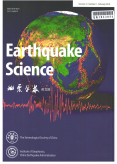- 钛学术文献服务平台 \
- 学术期刊 \
- 基础科学期刊 \
- 天文学、地球科学期刊 \
- 地震学报(英文版)期刊 \
Recent advances in earthquake monitoring Ⅱ: Emergen-ce of next-generation intelligent systems
Recent advances in earthquake monitoring Ⅱ: Emergen-ce of next-generation intelligent systems
基本信息来源于合作网站,原文需代理用户跳转至来源网站获取
摘要:
Seismic data processing techniques, together with seismic instrumentation, determine our earth-quake monitoring capability and the quality of resulting earthquake catalogs. This paper is intended to review the improvement of earthquake monitoring capability from the perspective of data processing. Over the past two decades, seismologists have made considerable advancements in seismic data processing, partly thanks to the significant develop-ment of computational power, signal processing, and machine learning techniques. In particular, wide application of temp-late matching and increasing use of deep learning signifi-cantly enhance our capability to extract signals of small earthquakes from noisy data. Relative location techniques provide a critical tool to elucidate fault geometries and seismicity migration patterns at unprecedented resolution. These techniques are becoming standard, leading to emerging intelligent software systems for next-generation earthquake monitoring. Prospective improvements in future research must consider the urgent needs in highly generalizable detection algorithms (for both permanent and temporary deployments) and in emergency real-time monitoring of ongoing sequences (e.g., aftershock and induced seismicity sequences). We believe that the maturing of intelligent and high-resolution processing systems could transform traditi-onal earthquake monitoring workflows and eventually liberate seismologists from laborious catalog construction tasks.

推荐文章
The enhanced element enrichment in the supercritical states of granite–pegmatite systems
Granites
Pegmatites
Supercritical state
Extreme element enrichment
单NEXT下军用被覆线的跨层容量分析
军用被覆线
跨层容量分析
溢出概率
有效信道容量
The morphological characteristics of gully systems and watersheds in Dry-Hot Valley, SW China
Morphological characteristics
Quantitative relationships
Gully system
Watershed
Dry-Hot Valley
内容分析
关键词云
关键词热度
相关文献总数
(/次)
(/年)
引文网络
引文网络
二级参考文献 (0)
共引文献 (0)
参考文献 (0)
节点文献
引证文献 (0)
同被引文献 (0)
二级引证文献 (0)
2021(0)
- 参考文献(0)
- 二级参考文献(0)
- 引证文献(0)
- 二级引证文献(0)
引文网络交叉学科
相关学者/机构
期刊影响力
地震学报(英文版)
主办单位:
中国地震学会
出版周期:
双月刊
ISSN:
1674-4519
CN:
11-5695/P
开本:
16开
出版地:
北京民族学院南路5号(北京8116信箱)
邮发代号:
创刊时间:
1980
语种:
eng
出版文献量(篇)
1366
总下载数(次)
0
期刊文献
相关文献
推荐文献
- 期刊分类
- 期刊(年)
- 期刊(期)
- 期刊推荐
力学
化学
地球物理学
地质学
基础科学综合
大学学报
天文学
天文学、地球科学
数学
气象学
海洋学
物理学
生物学
生物科学
自然地理学和测绘学
自然科学总论
自然科学理论与方法
资源科学
非线性科学与系统科学
地震学报(英文版)2022
地震学报(英文版)2021
地震学报(英文版)2020
地震学报(英文版)2019
地震学报(英文版)2018
地震学报(英文版)2017
地震学报(英文版)2016
地震学报(英文版)2015
地震学报(英文版)2014
地震学报(英文版)2013
地震学报(英文版)2012
地震学报(英文版)2011
地震学报(英文版)2010
地震学报(英文版)2009
地震学报(英文版)2008
地震学报(英文版)2007
地震学报(英文版)2006
地震学报(英文版)2005
地震学报(英文版)2004
地震学报(英文版)2003
地震学报(英文版)2002
地震学报(英文版)2001
地震学报(英文版)2000
地震学报(英文版)1999
地震学报(英文版)2021年第6期
地震学报(英文版)2021年第5期
地震学报(英文版)2021年第4期
地震学报(英文版)2021年第3期
地震学报(英文版)2021年第2期
地震学报(英文版)2021年第1期

 免费查重
免费查重










